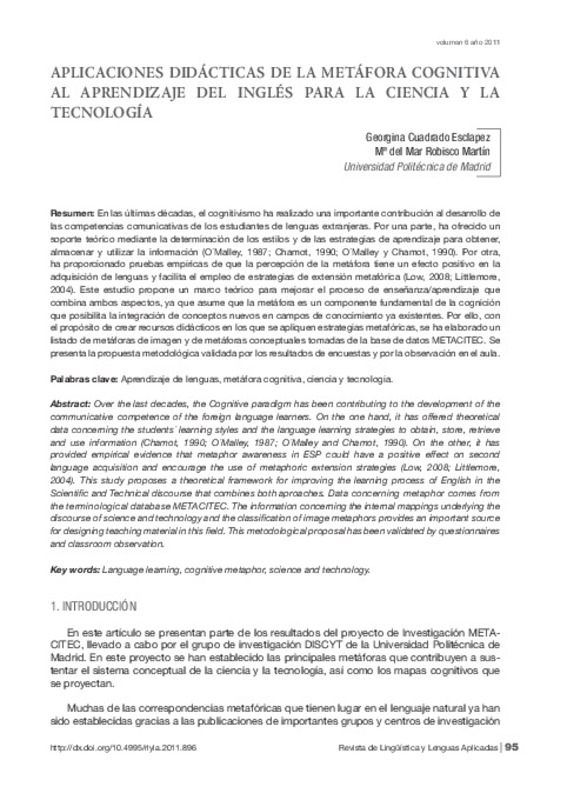JavaScript is disabled for your browser. Some features of this site may not work without it.
Buscar en RiuNet
Listar
Mi cuenta
Estadísticas
Ayuda RiuNet
Admin. UPV
APLICACIONES DIDÁCTICAS DE LA METÁFORA COGNITIVA AL APRENDIZAJE DEL INGLÉS PARA LA CIENCIA Y LA TECNOLOGÍA
Mostrar el registro sencillo del ítem
Ficheros en el ítem
| dc.contributor.author | Cuadrado Esclápez, Georgina
|
es_ES |
| dc.contributor.author | Robisco Martí, Mª del Mar
|
es_ES |
| dc.date.accessioned | 2011-10-26T12:33:51Z | |
| dc.date.available | 2011-10-26T12:33:51Z | |
| dc.date.issued | 2011 | |
| dc.identifier.issn | 1886-2438 | |
| dc.identifier.uri | http://hdl.handle.net/10251/12396 | |
| dc.description.abstract | [EN] Over the last decades, the Cognitive paradigm has been contributing to the development of the communicative competence of the foreign language learners. On the one hand, it has offered theoretical data concerning the students ́ learning styles and the language learning strategies to obtain, store, retrieve and use information (Chamot, 1990; O ́Malley, 1987; O ́Malley and Chamot, 1990). On the other, it has provided empirical evidence that metaphor awareness in ESP could have a positive effect on second language acquisition and encourage the use of metaphoric extension strategies (Low, 2008; Littlemore, 2004). This study proposes a theoretical framework for improving the learning process of English in the Scientific and Technical discourse that combines both aproaches. Data concerning metaphor comes from the terminological database METACITEC. The information concerning the internal mappings underlying the discourse of science and technology and the classification of image metaphors provides an important source for designing teaching material in this field. This metodological proposal has been validated by questionnaires and classroom observation. | es_ES |
| dc.description.abstract | [ES] En las últimas décadas, el cognitivismo ha realizado una importante contribución al desarrollo de las competencias comunicativas de los estudiantes de lenguas extranjeras. Por una parte, ha ofrecido un soporte teórico mediante la determinación de los estilos y de las estrategias de aprendizaje para obtener, almacenar y utilizar la información (O'Malley, 1987; Chamot, 1990; O'Malley y Chamot, 1990). Por otra, ha proporcionado pruebas empíricas de que la percepción de la metáfora tiene un efecto positivo en la adquisición de lenguas y facilita el empleo de estrategias de extensión metafórica (Low, 2008; Littlemore, 2004). Este estudio propone un marco teórico para mejorar el proceso de enseñanza/aprendizaje que combina ambos aspectos, ya que asume que la metáfora es un componente fundamental de la cognición que posibilita la integración de conceptos nuevos en campos de conocimiento ya existentes. Por ello, con el propósito de crear recursos didácticos en los que se apliquen estrategias metafóricas, se ha elaborado un listado de metáforas de imagen y de metáforas conceptuales tomadas de la base de datos METACITEC. Se presenta la propuesta metodológica validada por los resultados de encuestas y por la observación en el aula. | |
| dc.language | Español | es_ES |
| dc.publisher | Editorial Universitat Politècnica de València | es_ES |
| dc.relation.ispartof | Revista de Lingüística y Lenguas Aplicadas | |
| dc.rights | Reserva de todos los derechos | es_ES |
| dc.subject | Aprendizaje de lenguas | es_ES |
| dc.subject | Metáfora cognitiva | es_ES |
| dc.subject | Language learning | es_ES |
| dc.subject | Cognitive metaphor | es_ES |
| dc.title | APLICACIONES DIDÁCTICAS DE LA METÁFORA COGNITIVA AL APRENDIZAJE DEL INGLÉS PARA LA CIENCIA Y LA TECNOLOGÍA | es_ES |
| dc.type | Artículo | es_ES |
| dc.date.updated | 2011-10-26T11:18:45Z | |
| dc.identifier.doi | 10.4995/rlyla.2011.896 | |
| dc.rights.accessRights | Abierto | es_ES |
| dc.description.bibliographicCitation | Cuadrado Esclápez, G.; Robisco Martí, MDM. (2011). APLICACIONES DIDÁCTICAS DE LA METÁFORA COGNITIVA AL APRENDIZAJE DEL INGLÉS PARA LA CIENCIA Y LA TECNOLOGÍA. Revista de Lingüística y Lenguas Aplicadas. 6:95-106. https://doi.org/10.4995/rlyla.2011.896 | es_ES |
| dc.description.accrualMethod | SWORD | es_ES |
| dc.relation.publisherversion | https://doi.org/10.4995/rlyla.2011.896 | |
| dc.description.upvformatpinicio | 95 | |
| dc.description.upvformatpfin | 106 | |
| dc.description.volume | 6 | |
| dc.identifier.eissn | 1886-6298 | es_ES |








